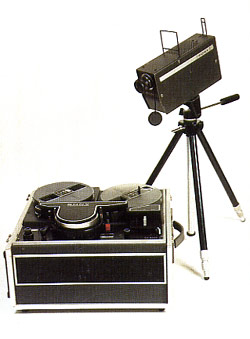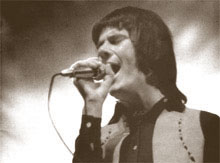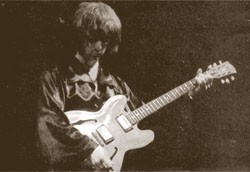Tetragrammaton
pulled out all the stops to secure Deep Purple a prestigious U.S. live
debut on October 18th 1968, opening for Cream on their farewell tour
of America at the Forum in Inglewood, California.
For
Deep Purple's first live show on American soil they also made a rough
black & white video recording to analyse the band's stage performance.
Maybe they were was also there to check another recent acquisition,
the world's first production-line 'home'  video-tape
recorder and portable video camera, both introduced by Sony in 1967.
The results captured through the camera (equipped only with an awkward
turret lens to zoom in) were not at all impressive. Tetragrammaton played
back Purple's 50 minute support performance to the group soon afterwards,
and no-one could really have learnt much from it. The picture was just
a grey fog, with the figures of the band just about visible through
the gloom. Whenever they moved the primitive tube technology of the
camera caused 'ghosting', which made things even worse. video-tape
recorder and portable video camera, both introduced by Sony in 1967.
The results captured through the camera (equipped only with an awkward
turret lens to zoom in) were not at all impressive. Tetragrammaton played
back Purple's 50 minute support performance to the group soon afterwards,
and no-one could really have learnt much from it. The picture was just
a grey fog, with the figures of the band just about visible through
the gloom. Whenever they moved the primitive tube technology of the
camera caused 'ghosting', which made things even worse.
The good news was that the accompanying audio recording turned out well
and that the fifty minute support set also fitted neatly onto a reel
of 0.5 inch videotape. Effectively even the audio was still just a superior
audience recording however, so when Warners took over Tetragrammaton
in 1970, the tape went into the dumpster.. Fortuitously it was rescued,
and eventually reached the hands of the DPAS. A poor quality copy also
leaked out on a Japanese bootleg cd, but we still had to wait to hear
the tape at its best.
Now,
the audio track has been cleaned up from the original transfer, and
released as the second of the 'Sonic Zoom' series of Deep Purple live
archive releases. So little evidence of Mk 1's live act remains that
the recording is of real historical significance.Regarding the actual
sound quality, Purple Records'
site mentions that "you soon get used to the ambience,
with just a little distortion in the second number and someone in the
audience heard near the microphone at one or two quiet moments."
It's true enough, and the sound is certainly markedly better than on
the bootleg. The hiss has gone (not counting the buzzing of the amps),
and there is a sharpness to the recording that was buried on the bootleg.
(Being able to hear Ian Paice's cymbal taps counting in the first crashing
chord of Hush for starters!) The qualty is easily good enough to make
for a pleasurable (and fascinating) listen, great news for anyone who
can enjoy a good, clear vintage audience recording of Deep Purple. But
if you're expecting hi-fi stereo, or even a miracle clean-up, it would
be best to approach with caution.
David Browne
I
think by now most avid Deep Purple fans will be aware of the existence
of this tape, many too will have picked up the bootleg cd 'Inglewood
10.18.68' to see exactly what Mk I
sounded like and how well (or otherwise) Simper and Evans fitted in.
 Hush heralds the entry of the band, very close to the album version but performed
with some vigour and energy, the sound really benefiting from the clean-up
afforded to the release. Kentucky Woman is vocally overloaded,
Rod Evans struggling to hit the chorus at the end, though the song is
well received by the audience. The applause is cut short as the band
plow headlong into a slightly discordant Mandrake Root. Hush heralds the entry of the band, very close to the album version but performed
with some vigour and energy, the sound really benefiting from the clean-up
afforded to the release. Kentucky Woman is vocally overloaded,
Rod Evans struggling to hit the chorus at the end, though the song is
well received by the audience. The applause is cut short as the band
plow headlong into a slightly discordant Mandrake Root.
Rod
certainly sounds well out of place with his crooning voice. Definitely
odd after years of living with Gillan's powerful assault. It's extended
from the studio cut, though still nowhere near the lengthy excesses
of the MkII versions. The track in itself forms an interesting work
in progress document, with some close similarities already there with
the sections which eventually found their way into Space Truckin'.  Help is musically tight and energetic though it does again suffer vocally.
This is more than counterbalanced by the instrumental assault, Jon letting
fly in the middle followed by a pretty truly awful solo by Blackers.
The track sounds less tentative than on 'Shades.....', taken faster
it is again well received by the crowd who are again cut short in their
appreciation by an initially somewhat perfunctory run through of Wring
That Neck. Blackers really begins to let fly here, bending the
strings all over the place and keeping everything just the right side
of total chaos. Paicey is, as ever, the stalwart. This guy has been
so consistantly blowing away every other drummer for aeons, and his
physical abuse of the drum kit in `68 is still no less restrained these
days. Here, though, he drives everything along, holding together the
tentative approaches of Ritchie, Jon and Nicky to draw things tighter. Help is musically tight and energetic though it does again suffer vocally.
This is more than counterbalanced by the instrumental assault, Jon letting
fly in the middle followed by a pretty truly awful solo by Blackers.
The track sounds less tentative than on 'Shades.....', taken faster
it is again well received by the crowd who are again cut short in their
appreciation by an initially somewhat perfunctory run through of Wring
That Neck. Blackers really begins to let fly here, bending the
strings all over the place and keeping everything just the right side
of total chaos. Paicey is, as ever, the stalwart. This guy has been
so consistantly blowing away every other drummer for aeons, and his
physical abuse of the drum kit in `68 is still no less restrained these
days. Here, though, he drives everything along, holding together the
tentative approaches of Ritchie, Jon and Nicky to draw things tighter.
River
Deep, Mountain High musically sticks fairly closely to the original.
It includes the 2001 theme, though with a distinctly harder edge, lending
more weight and leaning further away from the poppier sound of the Book
Of Taliesyn original . Rounding the set off is Hey
Joe, again it's all there musically, though the sound is a bit
thin. Rod really seems out of place here, his chicken in a basket style
not gelling at all with the rest of the band.
Historically,
then, a great artefact and a crucial piece of the live jigsaw. Not a
classic Purple performance by any stretch of the imagination, but a
unique insight (so far) into the abilities of the band at this stage
of it's development.
review:
Martin Ashberry
|